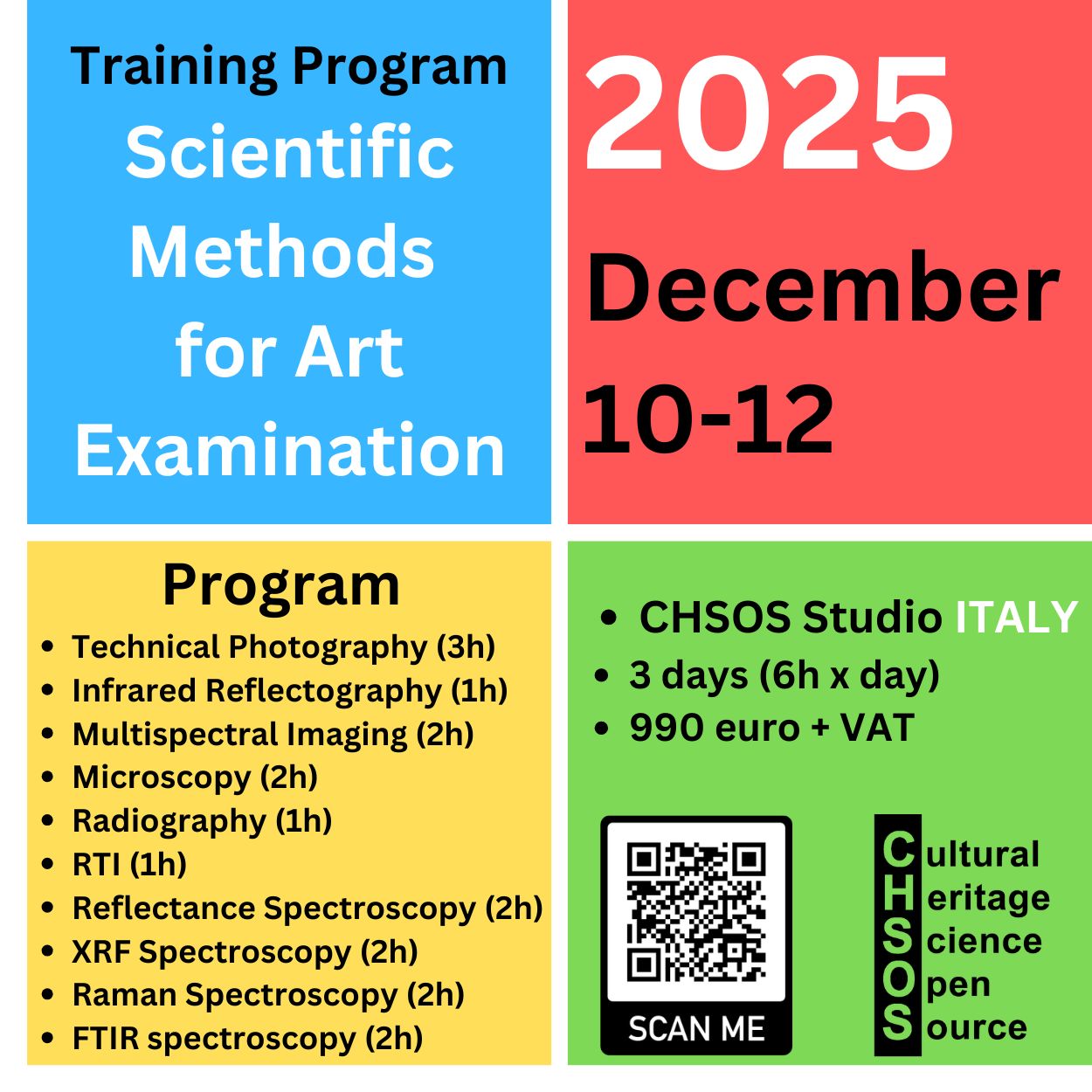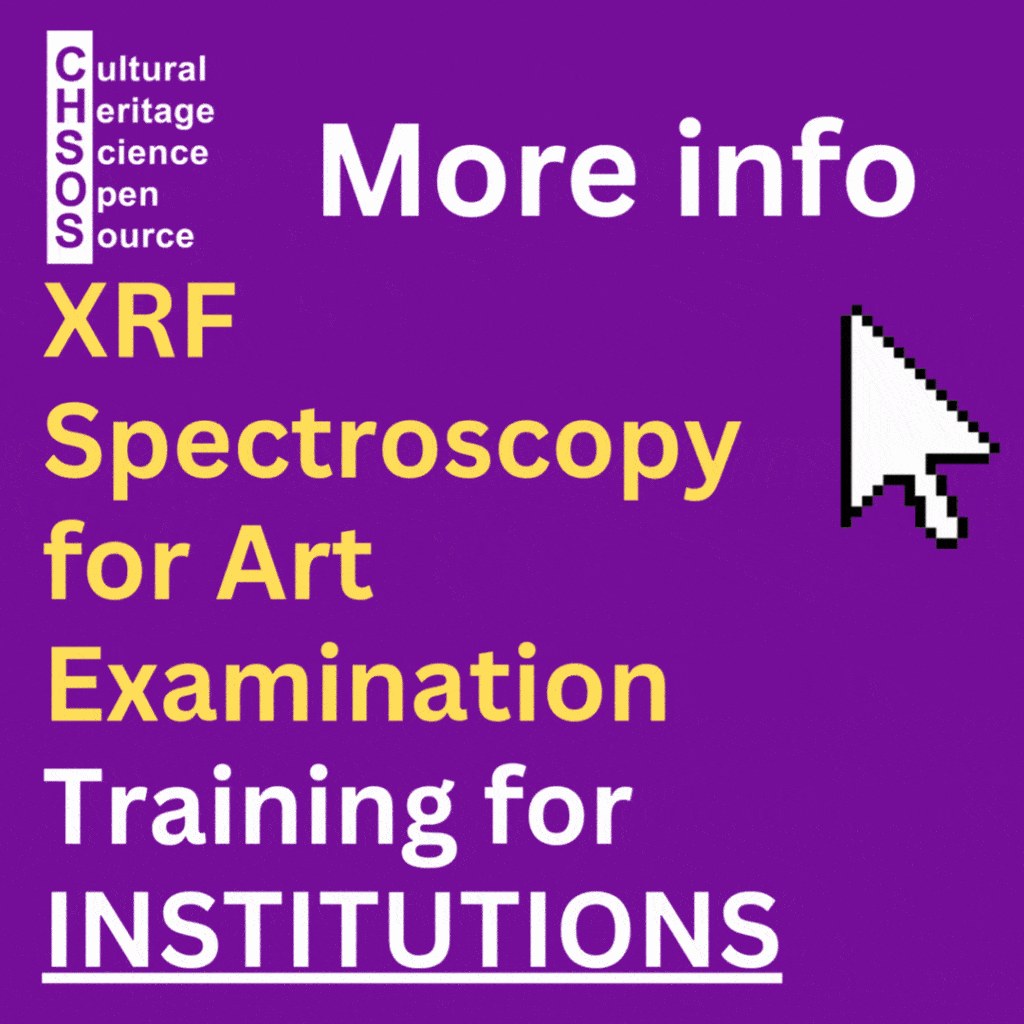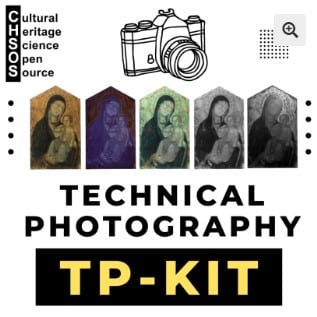Home » About » CHSOS Application Notes » CHSOS Application note # 2: FTIR Diffuse Reflectance. Pigments Checker Database
CHSOS Application note # 2: FTIR Diffuse Reflectance. Pigments Checker Database
FTIR Spectroscopy Examination of Art
We perform molecular analysis using an Agilent 4300 Handheld FTIR spectrometer. This system enables direct, non-invasive analysis of artworks and archaeological objects on their surfaces, without any damage or sampling. The technique, known as FTIR Diffuse Reflectance Spectroscopy, requires a specialized probe.
This method differs significantly from standard FTIR spectroscopy and can produce very different results. Therefore, researchers must develop new spectral databases for historical pigments and other materials used in art and archaeology.
Standard FTIR spectroscopy has been widely used in this field [1]. Its spectra are relatively easy to interpret since the IR radiation is either absorbed or transmitted. In contrast, FTIR Diffuse Reflectance involves additional scattering, which makes interpretation more complex. Scattering can vary significantly—even between samples of the same material [2]—leading to spectra that differ from those in standard databases.
CHSOS supports this effort by publishing spectra from the Pigments Checker, our reference collection of historical pigments from antiquity to the early 1950s. We applied the pigments with an acrylic binder on cardboard supports and collected spectra of both the pigments and the binder alone. All spectra are freely available on the Pigments Checker webpage.
Pure powder pigments
The FTIR-DR spectrum of a pigment in the Pigments Checker (Figure [1]) reflects contributions not only from the pigment itself, but also from the acrylic binder and the cardboard support (100% cotton paper). As a result, we cannot clearly identify the absorbance bands of each individual pigment.
Figure [2], for example, compares the spectrum of pure azurite powder with that of the azurite swatch in the Pigments Checker. This comparison shows the importance of having spectra of pure powder pigments to correctly interpret the spectra from painted surfaces.
To address this need, we created a spectral database of pure powder pigments. Users can download this database, along with the others, from the Pigments Checker webpage.

Checker.

In order not to contaminate the probe, the spectra of the pure pigments were acquired by depositing some powder on an IR transparent window, which does not affect the resulting spectrum, figure [4].
This window is then loaded on the probe, figure [5].

![Figure [5]. The IR transparent window holding the powder pigment is loaded on the probe for
the spectrum acquisition.](https://i0.wp.com/chsopensource.org/wp-content/uploads/2022/04/ftir-pigments-5-1.jpg?resize=980%2C510&ssl=1)
the spectrum acquisition.
Case study: antiphonary
We tested a large (68 x 47 cm) three-color antiphonary parchment sheet, 16th century, figure[6]. Figure [7] shows the spectra of the parchment, the blue color of a letter, and the spectrum of pure azurite in our database. Availability of the pure spectrum of azurite is mandatory for a correct interpretation.


Conclusions
Non-invasive FTIR with diffuse reflectance probe is a quite novel field. While standard FTIR spectra are easy to interpret, in the case of diffuse reflectance, the use of databases is mandatory. This application note discussed the spectra taken on Pigments Checker, but also the database taken from powder pigments. This helps to understand the effect that the binder has on the spectrum of the pigment. In upcoming application notes we will discuss the effect of other binders on the same pigments.
References
[1] DERRICK, M. R., STULIK, D., & LANDRY, J. M. (1999). Infrared spectroscopy in conservation science. Los Angeles, Getty Conservation Institute. http://www.getty.edu/conservation/publications/pdf_publications/infrared_spectroscopy.pdf.
[2] MILOSEVIC, M., & BERETS, S. L. (2002). A REVIEW OF FT-IR DIFFUSE REFLECTION SAMPLING CONSIDERATIONS. Applied Spectroscopy Reviews. 37, 347-364.
DOWNLOAD Application note #2: FTIR Diffuse Reflectance. Pigments Checker Database (3350 downloads )
Resources on FTIR Spectroscopy for Art Examination
1. Database of Diffuse Reflectance Infrared Fourier Transform Spectroscopy (DRIFTS) & Hyperspectral Imaging for Historical Pigments
This open-access study (Analytical & Bioanalytical Chemistry, June 2025) introduces a comprehensive spectral database combining DRIFTS and hyperspectral imaging, featuring 156 painting mock-ups with variations in binders, supports, and grain sizes. It’s designed to aid the identification of pigments and dyes used in historical manuscripts through non-invasive methods.
2. Fourier Transform Infrared (FTIR) Database of Historical Pigments: ATR‑FTIR vs. DRIFT Modalities
Published in Applied Sciences (March 2025), this resource provides spectra for 19 historical pigments—including silicates, carbonates, oxides, sulphides, and acetates—recorded using both ATR and DRIFT techniques. It emphasizes the practical value and limitations of DRIFT in the field.
3. Diffuse Reflection FTIR Spectral Database of Dyes and Pigments
This foundational 2006 study characterizes 24 common artistic pigments using diffuse-reflectance FTIR and validates the results against absorption FTIR. It marks the first application of this method in conservation science and highlights its utility for pigment identification







